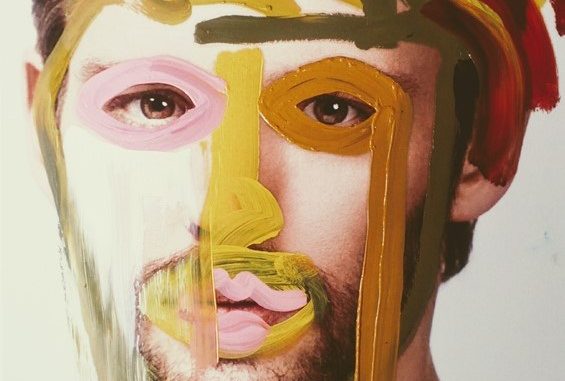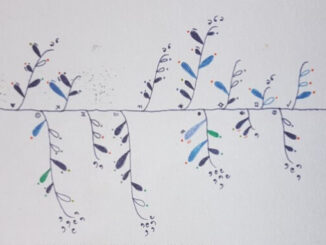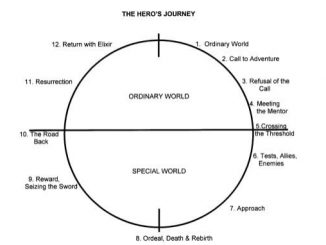
The psychiatrist and founder of analytical psychology C. G. Jung explained, “All the most powerful ideas in history go back to archetypes.”[1] Archetypes are said to be psychic power patterns dwelling in the deeper layers of the unconscious. According to Jung, the collective unconscious is part of the unconscious mind, incorporating patterns of memories, instincts, and experiences common to humankind.[2] The collective unconscious doesn’t exist in a geographical space, or in a part of the brain, or in a research report. Rather, it exists in the field of our connected humanity, which we may access through the presence of archetypes.
Archetypes are a symbolic language of the universe and provide a roadmap to help us read life. This language (or syntax) is embedded within our psyches. By accessing and decoding these patterns we can translate the universal to the personal, the collective to the individual, and in this sense, archetypes assist us in making what’s invisible, visible.
Concepts about such patterns do not belong solely to esoteric discourse. When we walk the city streets the semi-conscious survival mechanism in each of us is always questioning the invisible threads of power to which another individual is connected. We’re always sensing the archetypal patterns, individuated within people and societies, whether we’re aware of it or not.
The Influence of Symbols
It is not commonly recognized that among the many significant shapers of cultural forces is the archetypal realm. These archetypal energetic companions live through us in the physical world by influencing the formation of our rituals, symbols, emotions, behaviors, imagination, perception, ideas and choices. Archetypes are crucial to understand in futures studies, as we move from linear consciousness to embracing a spherical and holographic awareness, for the sense-making and meaning-making capabilities they provide.
In themselves, archetypes are essentially neutral, while comprised of both light and shadow characteristics. This means that their agendas, power dynamics, and motivations can be as beneficial as they are destructive. For instance, if we don’t make contact with, and integrate the shadow (the disowned, disassociated fragments of a pattern), we will meet this largely unconscious element as a projection, a distorted vision.
When archetypes live in us unconsciously, they have a degree of psychic energy that’s largely unavailable to us. This energy can animate on its own accord. To reclaim this dispossessed energy, we must recognize, transform and then integrate it back into our healthy selves, analogous to how the grit in an oyster makes a pearl.
How Archetypes Reveal Us
Now it is not to say that these universal patterns and experiences wholly define us. Rather, they reveal us. Archetypes enable us to access deeper levels of insight, wisdom and creativity that exist beyond the limits of the rational, linear mind (as necessary as this mind is). We increase our consciousness through awareness of the archetypal realm because it gives us co-ordinates of otherwise unconscious data, which we may feel, identify and language in physical space and time.

In January I spoke at the Verslo žinios conference in Vilnius, Lithuania about what I felt would be the four influential archetypes for 2020: Hermit, Healer, Trickster, Liberator. We’re currently experiencing these patterns in their shadow forms: externally imposed isolation; disruptive/destructive health issues; chaos/fake news; tyranny. To be honest, at the beginning of the year, I personally perceived the expression of these patterns rather differently.
Some Archetypes
I was considering the Hermit more in regards to the power of introverts and how hermitage can be by choice or force, but that nevertheless, we all must encounter stillness. Endless thoughts plague most people – hermits develop the capacity to leave the container of the mind somewhat empty so that they can develop a compassionate curiosity concerning society and culture. I then thought that the presence of this archetype was hinting not at getting away from the stress of modern-day life and becoming a defensive recluse that wants nothing to do with others, or focusing on focus instead of practicing continuous partial attention, but honestly assessing our deeper relationship to silence.
With the Healer, I was contemplating how we could bear the pain of others in an honorable spirit and the role of tenderness, kindness, and compassion, both on and offline. When there’s a lack of reverence for a holistic perspective, what are the community and civic interactions that can provide social nourishment and an altruism that extends beyond one’s immediate sense of self and present time frame? The true mark of a Healer is the ability to create, catalyze and channel lasting, beneficial change, while the shadow Healer preaches (and doesn’t listen) to clients and is more interested in their own ego inflation than actually imparting authentic healing. I was also simultaneously reflecting how in the corporate world, diagnoses often feel more like a curse than a cure, and how a more profound and life-affirming hope could be cultivated instead.

The Trickster is often viewed as a duplicitous, mischievous outsider, over-stepping bounds and landing us in situations that are both a blessing and a curse. It asks us to no longer frame experiences as either good or bad, but rather to move from an either/or perspective to embrace both/and. In January I perceived the Trickster as asking us to map our patterns and to tend and befriend our shadows, as the archetype is incredibly dextrous at finding what’s hidden and highlighting our fears. It would break what we no longer wanted and create what we secretly wished for (though were too afraid to actualize), as it chaotically made room for the new.
The Liberator rides the winds of change and promotes messages and actions of light that pierce the dark veils of ignorance that hold us captive and enslaved. Often unconventional and contrarian, the pattern harnesses a courageous and adventurous attitude to dismantle inequality, brutality and redundant, staid, expired systems. I was reflecting on how thinking, feeling and acting beyond the bounds of conventional mores (while meeting the opposing forces that want to keep the status quo) requires an empathetic perspective that honors the sacredness of all things – the earth and all her creatures – together with an increasingly expanding vision of the wider cosmos.

Archetypes are multidimensional and can be read at so many different levels. That’s what makes the study of them so fascinating and concurrently challenging! When we recognize a pattern, instead of ignoring it, or denying its presence, it can become our companion and ally by engaging it consciously. We don’t eradicate a pattern. Rather we transition the pattern alchemically, from its shadow manifestation into its light qualities.
By attuning ourselves to the archetype’s patterning through an internal recalibration, it gives us greater awareness in activating new choices, responses and actions. So how can we today, in March, and onwards throughout the year, work with the light attributes of these four archetypes?
Hermit: Turning inward is necessary for growth (each year has a winter, every project a cocoon stage). Hibernation, solitude, introspection, and reflection – hermitage – are crucial for our expansion. Instead of filling the silent space with trivial busywork (or worry), can we instead endeavor to come into contact with the treasure that only silence can bring?
Healer: Healing is not just about illness. To heal means to make whole, to come into balance. So how can we bring a healing lens to the many aspects of our lives – and collective systems – that require repair? Can we make healing choices? Holistic, interconnected choices that honor our communities, our beloved planet and ourselves.
Trickster: This pattern exposes illusion, unveils our greatest insecurities and teaches us that everything contains its opposite (paradox is its calling card). It can assist us in breaking down conventions and undoing structures, which we no longer want or need. If we can perceive the Trickster as a messenger, what’s the guidance it offers to our previous blindness?
Liberator: Freedom. Hope. Courage. It’s time to question what we are being held hostage to? What keeps us from rising to our potential? Can we liberate ourselves from fear? What inner and outer rebellion is required in this dark hour? Can we embody the ideals of Truth, Beauty, and Justice? The Liberator asks us to free ourselves – and the collective – from all forms of oppression.
As occurs within critical phases of cultural and societal development, we’re presently in a state of transition, a liminal phase. Forces of disintegration and integration occur simultaneously – redundant physical, political-cultural structures crumble, while the earth is also transforming, and the world psyche attempts to merge.
The Richness of Archetypes
Many people often want the world explained in a flat, simple narrative, but it is the subtle yet rich archetypal realm – accessed through attentive, active, engaged contemplation – that can lead one to clarity. When fruitfully engaged, this holographic universe can lead us to find an inner space of poise and heightened perspective, beyond the frequent ensnaring web of social media self-reinforcement with its many flat stereotypes and clichés.

By decoding the patterns in the collective unconscious, and how they’re constellating within each moment of time, we can enhance life’s meaning, rather than dwell within its impoverishments. Then we may encounter a future that many visionaries have claimed is reaching out to meet us, as we synchronously aspire to be informed, and formed, by its emerging potential.
By looking to the collective unconscious for guidance, we can begin to foster a relationship between our two levels of existence, namely the collective, impersonal and often (apparently) abstract archetypal, with the incarnate personal and increasingly individualized expressions of these patterns. What is being asked of us now is to augment beyond the common paradigm of the traditional, linear, rational mind to now include a spherical, heart intelligence – an intelligence that encompasses both earth time, and the visionary Dreamtime intelligence of ancient cultures, through a modern, wakeful consciousness.
Not only in times of crisis but every day, I recommend perceiving events from an archetypal and mythic perspective. To arrive at well-rounded meanings, we can’t enter through logic alone. I feel if we can think mythically and sense archetypally in our futures studies we can better understand our shared humanity, yet honor and appreciate the diverse ways we each live and make meaning. Developing an archetypal eye and working with symbolic and metaphoric narratives can assist us in welcoming uncertainty, navigating uncharted territory and making the unknown our new best friend.
Questions to Ask
What is your relationship like to the unknown? Can you exist in the liminal space? One will always have some trepidation of the unknown, but can we wield the type of creative power, as Odysseus must as ‘Nobody’ on Neptune’s seas in The Odyssey? Can we exist in the space in-between? In transformation, we don’t know who we will be on the other side. When we’re at a crossroads, we’re invited to go into the void of the unknown of our lives, to find comfort in the aloneness, with questions that are often unknowable and unanswerable. Growth has many dark nights of the soul, and evolution very many more.

It is as much about unlearning – an undoing like Penelope in The Odyssey as she awaits news of Odysseus – both weaving and unweaving the stitchings of her needlework. As must we, if we want our world to be symbolically rewoven. When we no longer recognize who we are, nor who we will be, we ‘get’ that we can’t activate the potentiality within us from yesterday – or tomorrow – only from where we are right here, right now, in the living sacred present. All growth occurs most magnanimously in the moment of where one is. Our best teacher is our very own experience if we can be open to its meaning.
For transformation, renewal, and rebirth to occur, it happens at the street level . . . at the imperfect, vulnerable, gritty, messy level of interaction and life. This work isn’t easy – but it is worthwhile – as together we ask inconvenient truths: “What’s conscious? What’s externalized as a projection? What’s in the shadow?” We can only be as competent, and as wise, as the shadow work, we’ve done.
To say we live in an amazing time in human history is an understatement. But by living in alignment with the illumination that the archetypal world bestows (and the insights which reside in the rhythms of nature), we will fixate less on prediction and concern ourselves more with presence. This will enable us to better relax into the future as we learn to make the mysterious and unknown our permanent home. Rather than constantly being consumed with what’s next, we will instead focus on what’s sacred. The honoring of the sacred is what will lead to true intimations of the future.
References and further reading:
[1] “Structure & Dynamics of the Psyche” is Volume 8 in The Collected Works of C. G. Jung
[2] Collins English Dictionary
- An Archetypal Eye on This Time of Change - 16th July 2020





Thank you, Kristina for this eye-opening article. I have been using what I now recognise to be archtypes in my games naratives and learning designs for some time now, without really realising that that was what I was doing. They are shortcuts to shared meaning which bring about so many A-ha moments. Now that I understand more – thanks to this article, I can be more deliberate about this and get even more value from this practice in my work.
Yes! We’re far more archetypally fluent than we think!